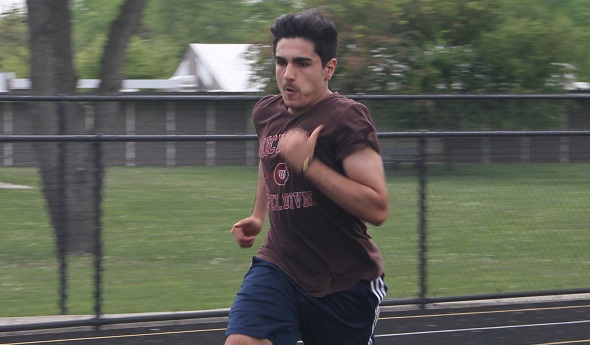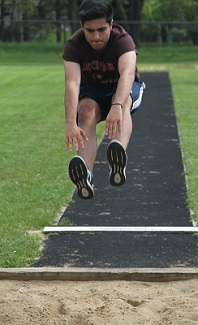
Parchment Enjoys Exchange of Experiences
By
Pam Shebest
Special for MHSAA.com
May 23, 2016
PARCHMENT — Pecan pie and snow are just two surprises Khaled Bukhamseen found as an exchange student at Parchment High School.
 “Pies are not as famous back home,” he said. “I actually learned how to make them so I can do that back home.
“Pies are not as famous back home,” he said. “I actually learned how to make them so I can do that back home.
“My favorite is pecan pie. Oh my gosh.”
The Dammam, Saudi Arabia, native, who played soccer in the fall and competed on the track & field team this spring, had never seen snow.
“It was pretty sweet the first couple times, but then I got sick of it,” he said, grinning. “It was like, ‘OK, we had fun, you can leave now.’
“I had to buy actual winter clothes.”
Another surprise was organized sports.
When Bukhamseen decided to try out for the Parchment track team, he figured he would just drop in for practice whenever he felt like exercising.
He got a reality check when he realized what a commitment he had to make.
“They told me about track and the activities you can do, like races,” he said. “I thought I would give it a try. I was pretty sure I would like it because I’m fast.
“I like the competition. Sometimes you do so good and you get first place and you feel like you’re the best on the team. That’s the good part about it.”
Parchment’s track season is over for all but the six individuals who qualified last week for the MHSAA Lower Peninsula Division 3 Finals. The exchange student is not one of them – but will finish his year in the United States with an experience valuable not only to him but his teammates and coaches as well.
The only high school sports at Bukhamseen’s school in Dammam are in physical education classes.
“I played soccer, but it was just a PE class where they try to vary the sports,” he said. “That was pretty much the only thing I did, and it was like once a week for 45 minutes.”
Once Bukhamseen showed interest in joining the track team, coach Matt Hodgson evaluated him for his strengths and weaknesses along with what the team needed.
“Khaled appeared to us to be stronger in the sprints than long distance,” Hodgson said. “I don’t think running five miles a day out on the road is something that interested him.”
 The coach also made sure the sprinter knew what was expected.
The coach also made sure the sprinter knew what was expected.
“Organized athletics (in Saudi Arabia) are not like they are in America,” Hodgson said. “In fact, one day we talked about it and he said when he first came out for track he thought it was something you kinda showed up for and practiced when you wanted to and made a meet when you wanted to.
“He said, ‘You don’t allow that, coach, do you?’ I said no; when you commit, you commit and you’re expected to be here every day.”
Bukhamseen competed in the 100- and 200-meter dashes, 400 relay and long jump.
Hodgson said Bukhamseen brought a lot of energy to the team.
“We always expect something quite hilarious to come out of his mouth daily,” the coach said. “He’s a good teammate who has really bonded with a lot of the kids on the team.
“Because he’s not used to this organization of athletics, he’s oftentimes running around saying ‘Coach, when’s my event, what am I doing?’ We always expect him to be a little frazzled at times at meets, and it’s quite comical.”
Bukhamseen wasn’t the only one benefiting from the exchange program. Members of the track team did, too.
“He’s given us a different perspective on the world, and he’s told us about the people of Saudi Arabia,” said Donavan Hodgson, the coach’s son, who runs anchor on the 400 relay team. He’s a really funny guy and a really cool guy, too.”
Students also are getting a lesson in culture.
“I think in the United States, especially, there’s a really bad rap on Muslims and people from those areas,” Donavan Hodgson said. “Khaled’s the exact opposite of what (some may) think. He’s the most passive-aggressive guy ever. He’s a really good guy.”
Bukhamseen started the school year with the Kellay Fall and Bill Evans family and for the last few months has lived with the Kira and Franz Griggs family.
 Kira Griggs was an exchange student in Paraguay when she was 15 years old and sees hosting a student as paying it forward.
Kira Griggs was an exchange student in Paraguay when she was 15 years old and sees hosting a student as paying it forward.
“They really integrate into your family much more than you think,” she said. “You adapt to each other; he’s just another family member.
“He’s a typical teenager; always on his phone, out with friends. His English is so perfect. He’s a great kid, a great student. He has a lot of friends.”
Bukhamseen said it is not unusual for Saudis to study in the United States, especially for college, and his two brothers are currently studying in Seattle.
Although his native language is Arabic, Bukhamseen speaks excellent English.
“In Saudi Arabia it’s mandatory to learn English in first grade,” he said. “My dad has kept it up with me. My dad went to Houston to college.”
Bukhamseen takes most of his class notes in English, but, “If I have a note to the side, I’d write it in Arabic quick, especially a vocab test every Friday,” he said. “I would write the equivalent of the word in Arabic so I wouldn’t forget it.”
Track wasn’t his only sport at Parchment.
When he first came to the United States in August, he integrated himself by joining the soccer team.
That also was an awakening.
“Having a team and a coach and practices, it’s way different than having it just once a week,” he said.
“I had to work out a little extra. They started earlier than me because I came a little late (August) to start the season.”
Soccer coach Matt Streitel has had exchange students on his teams before and said that each boy brings something different to the team.
“It’s cool,” he said. “You get that culture you might not get from other students.
 “Khaled had a little bit of skill and was excited to be there.”
“Khaled had a little bit of skill and was excited to be there.”
Bukhamseen had to go through a rigorous workshop before being accepted into the AFS Intercultural Program.
“Khaled has a great sense of humor,” said David Person, co-coordinator for the West Michigan chapter. “He had to go to Riyadh for orientation and he said it was from 7 to 8, so he thought he’d be in and out in an hour but it was a 13-hour orientation.
“What he had to go through to get here was very stringent. He’s the cream of the crop.”
Bukhamseen is also part of the YES Program, a government-sponsored youth exchange and study, Person said.
“He’s here under U.S. government scholarship,” he said. “They go out and choose the best students ever, the future leaders.
“The YES Program works with programs that have large Muslim populations. He’s one of three YES students in this (southwest Michigan) area.”
The others are at Kalamazoo Central and Battle Creek Central.
 Pam Shebest served as a sportswriter at the Kalamazoo Gazette from 1985-2009 after 11 years part-time with the Gazette while teaching French and English at White Pigeon High School. She can be reached at [email protected] with story ideas for Calhoun, Kalamazoo and Van Buren counties.
Pam Shebest served as a sportswriter at the Kalamazoo Gazette from 1985-2009 after 11 years part-time with the Gazette while teaching French and English at White Pigeon High School. She can be reached at [email protected] with story ideas for Calhoun, Kalamazoo and Van Buren counties.
PHOTOS: (Top) Khaled Bukhamseen rounds a turn during a recent Parchment track practice. (Middle top) Bukhamseen, Parchment coach Matt Hodgson, teammate Donavan Hodgson. (Middle below) Bukhamseen trains in the long jump. (Below) David Person, Kira Griggs. (Photos by Pam Shebest.)

Hastings Relays Reigns as State's Oldest Continuous Track & Field Meet
By
Steve Vedder
Special for MHSAA.com
April 10, 2024
Bob Branch remembers dabbling in other sports, but his first love was always running.
 The Hastings High School graduate admits he could never hit a baseball, football didn't especially appeal to him and basketball was just another way to spend time with friends. But for Branch, now 93, there was always track. That's the sport where his fondest and sharpest memories remain. And if you're talking track, many of his favorite memories come from participation in the state's oldest continuous track meet, the Hastings Relays.
The Hastings High School graduate admits he could never hit a baseball, football didn't especially appeal to him and basketball was just another way to spend time with friends. But for Branch, now 93, there was always track. That's the sport where his fondest and sharpest memories remain. And if you're talking track, many of his favorite memories come from participation in the state's oldest continuous track meet, the Hastings Relays.
Always held in early April, the meet dates back to 1937 – a bygone time that saw the first hostilities of World War II, gas at 20 cents a gallon and a loaf of bread selling for a dime.
And at a dusty old track surrounding the county fairgrounds in Hastings, a small relay event that included a scattering of participants from a dozen high schools was taking its first tentative steps.
Branch recalls a time when kids would run home after track practice because there were no buses, inexperienced young coaches had little actual knowledge of running fundamentals, and athletes looked at the sport as an afterthought after spending most of their high school days playing football and basketball.
 For Branch, the relays were the ideal way to ease into the track season.
For Branch, the relays were the ideal way to ease into the track season.
"I just liked to run," said Branch. "I remember I anchored a relay with my brother, and it always seemed cold when we had that meet. I remember teams would come from all over and you saw a lot of good athletes. Everybody seemed to have someone who was really good. Track wasn't very popular at that time, but I have a lot of good memories from running."
The Hastings Relays, which has changed formats and even names during its nearly nine-decade history, would traditionally kick off the track season. The meet was originally held at a makeshift quarter-mile track which surrounded the town's fairgrounds and was part of the city's annual Hastings Carnival – the track would become the midway during fair time.
The meet eventually moved to Johnson Field when the football field was dedicated in 1949 and ballooned to as many as 50 teams at its peak in 1957. For more than seven decades it was known as the Hastings Relays and then the Hastings Co-Ed relays before becoming the current Hastings Invitational, with the latest edition scheduled for Friday.
Johnson Field had a cinder track before it became an all-weather surface in the 1980s. During a time long before computers would be used to organize meet heats in mere minutes, Hastings coaches of all sports – defined as "volunteers" by the athletic department – would meet on the Friday before competition to hash out events.
People associated with the meet still recall the camaraderie built on those long Friday nights, followed by working what would often become 10-hour meets. Steve Hoke has been involved since watching his father, Jack, who coached teams at 15 of the meets beginning in 1951 and also had run in the first Hastings Relays. Steve Hoke later competed in the Relays as well during the early 1970s before becoming an assistant track coach, later the Hastings athletic director and now a volunteer worker.
"It was always a huge deal," said Hoke, who said the meet began as a pure relay event before transitioning to its current team format in the 1990s. "I remember we'd line the track the night before, and all the coaches would come to the house to organize everything. There was a brotherhood.”
 If you quiz many of the fleet of volunteers who've worked the relays over the years, each has a different memory from the meet. While Hoke describes the brotherhood and Branch the outstanding competition, others remember weather and the time a thunderstorm wiped out the line markings on the cinder track, or waking up to find three inches of snow that caused a rare cancellation of the meet. Others recall the shock of moving from the cinder to all-weather track or using the meet as an early measuring stick of what it would take to qualify for the state meet. The real old-timers remember the meet disappearing for three years during World War II.
If you quiz many of the fleet of volunteers who've worked the relays over the years, each has a different memory from the meet. While Hoke describes the brotherhood and Branch the outstanding competition, others remember weather and the time a thunderstorm wiped out the line markings on the cinder track, or waking up to find three inches of snow that caused a rare cancellation of the meet. Others recall the shock of moving from the cinder to all-weather track or using the meet as an early measuring stick of what it would take to qualify for the state meet. The real old-timers remember the meet disappearing for three years during World War II.
Hastings native and Western Michigan grad Tom Duits was the state’s second collegian to break the four-minute mile when he ran a 3:59.2 at a meet in Philadelphia in 1978. Duits, who ran in three Hastings Relays, was in line to join the U.S. Olympic team in 1980 before the United States pulled out of the games due to tension with Russia.
Duits has his own memories of the meet and the competition he faced there.
"I remember sunshine and being excited to be competing again. There were all these athletes swarming around; it was an awesome display of talent," he said. "It was always one of the best meets we'd be in. You could pretty much see the level of runners who would be at state, which made it a big deal. It was always early, but you could tell where you stood. It was great exposure."
Hastings track star Wayne Oom competed in four Hastings Relays from 1984-87. One of his sharpest memories was the difference between running on a raw cinder track versus the far more comfortable all-weather surface.
"Those cinders would grind into your skin," said Oom, part of the Hastings school record in the two-mile relay. "But I think it helped us because when we'd go to other tracks, it seemed we would run faster. I remember how competitive it was, especially in the distances. There were some great runners."
While participants have their unique memories, so do coaches. Former Saxons coach Paul Fulmer remembers 2008 when his team finished first on the boys side of the meet while his wife, Grand Haven coach Katie Kowalczyk-Fulmer, saw her girls team win the championship.
 "I knew we were one of the favorites to win because we were usually near the top of our conference and Regional," he said. "But then Katie's team was pretty good, and it was cool for them to win too."
"I knew we were one of the favorites to win because we were usually near the top of our conference and Regional," he said. "But then Katie's team was pretty good, and it was cool for them to win too."
Fulmer, who coached Hastings from 1978-81 and then 1985-2010, said at least part of the meet's popularity was derived from a unique way of scoring. Instead of individuals earning points solo, participants worked in pairs. For instance, two athletes would combine their shot put or long jump scores. New events such as the 1,500 relay and sprint medley were added.
"We had a tradition of being the state's oldest meet, and that was a big deal," Fulmer said. "And we ran a good relay; that attracted teams too. We took a lot of pride in that.
"And we'd get quite a lot of people to come to the meet. We'd set up until like 9 or 10 p.m., and then we'd have a party with all the coaches on Friday night."
While the meet has stretched 87 years, Branch said early participants and current runners have one thing in common: a drive to win. Branch ran in an era when the popularity of high school track was in its infancy. Today some of the best all-around athletes at a school are involved in the track program. The relays span the nearly nine decades in between.
"The quality of teams has gotten better and better," said Branch, the 1947 Lower Peninsula Class B Finals champ in the 220. "And this has made for a better meet. We would get guys who played football or baseball kind of drift into track, and that made the sport better. I think people began to appreciate track because we'd get teams from all over.
"We went from not really knowing what we were doing to track being a good sport. Even then, I'm not sure we appreciated what we had. We really liked the Hastings Relays and always wanted to do well there. It became popular and quite an honor to do well. Those are the kind of things I remember."
PHOTOS (Top) Racers run at the Hastings Relays, with several more awaiting their turns to compete at the longtime meet. (2) The author wrote on the 50th anniversary of the Relays for the Hastings Banner nearly 40 years ago. (3) Past athlete, coach and athletic director Steve Hoke shows some of the Relays awards from the 1930s. (4) Tom Duits was one of the state’s biggest track stars of the 1970s and ran in three Hastings Relays. (Top photo by Dan Goggins, Hoke photo provided by Steve Hoke and Duits photos provided by Tom Duits.)

